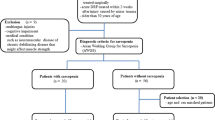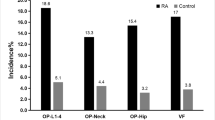Abstract
Summary
We evaluated the vitamin D receptor (VDR) expression in the forearm flexor muscle of women with distal radius fracture. High VDR expression was associated with low appendicular lean mass index.
Introduction
We aimed to evaluate the relationship between the VDR expression in the muscle cell and the muscle mass in women with a distal radius fracture (DRF).
Methods
We prospectively recruited 45 women over 50 years of age (mean age, 66 years) with DRF and acquired biopsy of the forearm flexor muscle. The muscle cross-sectional area (CSA) and VDR expression were measured using immunohistochemistry staining. The clinical parameters including grip strength, gait speed, body mass index (BMI), bone mineral density (BMD), and serum vitamin D levels were compared between patients grouped by appendicular lean mass index and were correlated with the VDR expression.
Results
Twelve patients (27%) showed a decreased appendicular lean mass index, less than the cut-off value of 5.4 kg/m2 which was suggested by the Asian Working Group for Sarcopenia. Patients with a low appendicular lean mass index had significantly lower muscle CSA (p = 0.037), but a higher VDR expression (p = 0.045) than those with higher indices. VDR expression was negatively correlated with BMI (r = − 0.417, p = 0.004) and appendicular lean mass index (r = − 0.316, p = 0.044).
Conclusions
DRF patients with low appendicular lean mass index presented high VDR expression and low CSA in forearm muscle cells. This suggests that the VDR expression might be upregulated in the attempt to compensate for the decreasing muscle mass. Further studies are necessary to explore the role of VDR in the progression of sarcopenia.

Similar content being viewed by others
References
Janssen I, Heymsfield SB, Wang Z, Ross R (2000) Skeletal muscle mass and distribution in 468 men and women aged 18–88 yr. J Appl Physiol 89(1):81–88
Lukaski HC (1996) Estimation of muscle mass; in Roche AF, Heymsfield SB, Lohman TG(eds): Human body composition. Human Kinetics, Champaign, pp 109–128
Lexell J, Taylor CC, Sjöström M (1988) What is the cause of the ageing atrophy?: total number, size and proportion of different fiber types studied in whole vastus lateralis muscle from 15-to 83-year-old men. J Neurol Sci 84(2):275–294
Frontera WR, Hughes VA, Fielding RA, Fiatarone MA, Evans WJ, Roubenoff R (2000) Aging of skeletal muscle: a 12-yr longitudinal study. J Appl Physiol 88(4):1321–1326
Lang T, Streeper T, Cawthon P, Baldwin K, Taaffe DR, Harris TB (2010) Sarcopenia: etiology, clinical consequences, intervention, and assessment. Osteoporos Int 21(4):543–559. https://doi.org/10.1007/s00198-009-1059-y
O'neill T, Marsden D, Adams J, Silman A (1996) Risk factors, falls, and fracture of the distal forearm in Manchester, UK. J Epidemiol Community Health 50(3):288–292
Mallmin H, Ljunghall S (1994) Distal radius fracture is an early sign of general osteoporosis: bone mass measurements in a population-based study. Osteoporos Int 4(6):357–361. https://doi.org/10.1007/bf01622198
Jang WY, Chung MS, Baek GH, Song CH, Cho HE, Gong HS (2012) Vitamin D levels in post-menopausal Korean women with a distal radius fracture. Injury 43(2):237–241. https://doi.org/10.1016/j.injury.2011.10.020
Cho YJ, Gong HS, Song CH, Lee YH, Baek GH (2014) Evaluation of physical performance level as a fall risk factor in women with a distal radial fracture. J Bone Joint Surg Am 96(5):361–365. https://doi.org/10.2106/jbjs.l.01359
Roh YH, Koh YD, Noh JH, Gong HS, Baek GH (2017) Evaluation of sarcopenia in patients with distal radius fractures. Arch Osteoporos 12(1):5. https://doi.org/10.1007/s11657-016-0303-2
Owen R, MELTON III L, Ilstrup D, Johnson K, Riggs B (1982) Colles’ fracture and subsequent hip fracture risk. Clin Orthop Relat Res (171):37-43
Visser M, Deeg DJ, Lips P, Longitudinal Aging Study A (2003) Low vitamin D and high parathyroid hormone levels as determinants of loss of muscle strength and muscle mass (sarcopenia): the Longitudinal Aging Study Amsterdam. J Clin Endocrinol Metab 88(12):5766–5772. https://doi.org/10.1210/jc.2003-030604
Snijder MB, van Schoor NM, Pluijm SM, van Dam RM, Visser M, Lips P (2006) Vitamin D status in relation to one-year risk of recurrent falling in older men and women. J Clin Endocrinol Metab 91(8):2980–2985. https://doi.org/10.1210/jc.2006-0510
Ceglia L, Harris SS (2013) Vitamin D and its role in skeletal muscle. Calcif Tissue Int 92(2):151–162. https://doi.org/10.1007/s00223-012-9645-y
Simpson RU, Thomas GA, Arnold AJ (1985) Identification of 1,25 dihydroxyvitamin D3 receptors and activities in muscle. J Biol Chem 260(July 25):8882–8891
Bischoff HA, Borchers M, Gudat F, Duermueller U, Theiler R, HB S¨a, Dick W (2001) In situ detection of 1,25dihydroxycitamin D3 receptor in human skeletal muscle tissue. Histochem J 33(1):19–24
Girgis CM, Clifton-Bligh RJ, Hamrick MW, Holick MF, Gunton JE (2013) The roles of vitamin D in skeletal muscle: form, function, and metabolism. Endocr Rev 34(1):33–83. https://doi.org/10.1210/er.2012-1012
Endo I, Inoue D, Mitsui T, Umaki Y, Akaike M, Yoshizawa T, Kato S, Matsumoto T (2003) Deletion of vitamin D receptor gene in mice results in abnormal skeletal muscle development with deregulated expression of myoregulatory transcription factors. Endocrinology 144(12):5138–5144
Chen LK, Liu LK, Woo J, Assantachai P, Auyeung TW, Bahyah KS, Chou MY, Chen LY, Hsu PS, Krairit O (2014) Sarcopenia in Asia: consensus report of the Asian Working Group for Sarcopenia. J Am Med Dir Assoc 15(2):95–101
Petersen P, Petrick M, Connor H, Conklin D (1989) Grip strength and hand dominance: challenging the 10% rule. Am J Occup Ther 43(7):444–447
Wang D, Li T, Ye G, Shen Z, Hu Y, Mou T, Yu J, Li S, Liu H, Li G (2015) Overexpression of the receptor for advanced glycation endproducts (RAGE) is associated with poor prognosis in gastric cancer. PLoS One 10(4):e0122697. https://doi.org/10.1371/journal.pone.0122697
Remmele W, Hildebrand U, Hienz HA, Klein P-J, Vierbuchen M, Behnken LJ, Heicke B, Scheidt E (1986) Comparative histological, histochemical, immunohistochemical and biochemical studies on oestrogen receptors, lectin receptors, and Barr bodies in human breast cancer. Virchows Archiv A 409(2):127–147
Ceglia L, Niramitmahapanya S, Price LL, Harris SS, Fielding RA, Dawson-Hughes B (2013) An evaluation of the reliability of muscle fiber cross-sectional area and fiber number measurements in rat skeletal muscle. Biol Proced Online 15(1):6
Ceglia L, Niramitmahapanya S, da Silva Morais M, Rivas DA, Harris SS, Bischoff-Ferrari H, Fielding RA, Dawson-Hughes B (2013) A randomized study on the effect of vitamin D3supplementation on skeletal muscle morphology and vitamin D receptor concentration in older women. J Clin Endocrinol Metab 98(12):E1927–E1935. https://doi.org/10.1210/jc.2013-2820
Cruz-Jentoft AJ, Landi F, Schneider SM, Zúñiga C, Arai H, Boirie Y, Chen L-K, Fielding RA, Martin FC, Michel J-P (2014) Prevalence of and interventions for sarcopenia in ageing adults: a systematic review. Report of the International Sarcopenia Initiative (EWGSOP and IWGS). Age Ageing 43(6):748–759
Kwon HJ, Ha YC, Park HM (2016) Prevalence of sarcopenia in the Korean woman based on the Korean National Health and Nutritional Examination Surveys. J Bone Metab 23(1):23–26
Silman A (2003) Risk factors for Colles' fracture in men and women: results from the European Prospective Osteoporosis Study. Osteoporos Int 14(3):213–218
Kelsey JL, Prill MM, Keegan TH, Tanner HE, Bernstein AL, Quesenberry CP, Sidney S (2005) Reducing the risk for distal forearm fracture: preserve bone mass, slow down, and don’t fall! Osteoporos Int 16(6):681–690
Simpson R, Thomas G, Arnold A (1985) Identification of 1, 25-dihydroxyvitamin D3 receptors and activities in muscle. J Biol Chem 260(15):8882–8891
Horst R, Goff J, Reinhardt T (1990) Advancing age results in reduction of intestinal and bone 1,25-dihydroxyvitamin D receptor. Endocrinology 126(2):1053–1057
Bischoff-Ferrari H, Borchers M, Gudat F, Dürmüller U, Stähelin H, Dick W (2004) Vitamin D receptor expression in human muscle tissue decreases with age. J Bone Miner Res 19(2):265–269
Kinyamu HK, Gallagher JC, Prahl JM, Deluca HF, Petranick KM, Lanspa SJ (1997) Association between intestinal vitamin D receptor, calcium absorption, and serum 1,25 dihydroxyvitamin D in normal young and elderly women. J Bone Miner Res 12(6):922–928. https://doi.org/10.1359/jbmr.1997.12.6.922
Pojednic RM, Ceglia L, Olsson K, Gustafsson T, Lichtenstein AH, Dawson-Hughes B, Fielding RA (2015) Effects of 1,25-dihydroxyvitamin D3 and vitamin D3 on the expression of the vitamin d receptor in human skeletal muscle cells. Calcif Tissue Int 96(3):256–263. https://doi.org/10.1007/s00223-014-9932-x
Bozsodi A, Boja S, Szilagyi A, Somhegyi A, Varga PP, Lazary A (2016) Muscle strength is associated with vitamin D receptor gene variants. J Orthop Res 34(11):2031–2037. https://doi.org/10.1002/jor.23220
Girgis CM, Cha KM, Houweling PJ, Rao R, Mokbel N, Lin M, Clifton-Bligh RJ, Gunton JE (2015) Vitamin D receptor ablation and vitamin D deficiency result in reduced grip strength, altered muscle fibers, and increased myostatin in mice. Calcif Tissue Int 97(6):602–610. https://doi.org/10.1007/s00223-015-0054-x
Garcia LA, King KK, Ferrini MG, Norris KC, Artaza JN (2011) 1, 25(OH)2vitamin D3 stimulates myogenic differentiation by inhibiting cell proliferation and modulating the expression of promyogenic growth factors and myostatin in C2C12 skeletal muscle cells. Endocrinology 152(8):2976–2986
Perez-Siles G, Grant A, Ellis M, Ly C, Kidambi A, Khalil M, Llanos RM, La Fontaine S, Strickland AV, Züchner S (2016) Characterizing the molecular phenotype of an Atp7a T985I conditional knock in mouse model for X-linked distal hereditary motor neuropathy (dHMNX). Metallomics 8(9):981–992
Frontera WR, Reid KF, Phillips EM, Krivickas LS, Hughes VA, Roubenoff R, Fielding RA (2008) Muscle fiber size and function in elderly humans: a longitudinal study. J Appl Physiol (1985) 105(2):637–642. https://doi.org/10.1152/japplphysiol.90332.2008
Brennan-Speranza TC, Mor D, Mason RS, Bartlett JR, Duque G, Levinger I, Levinger P (2017) Skeletal muscle vitamin D in patients with end stage osteoarthritis of the knee. J Steroid Biochem Mol Biol 173:180–184. https://doi.org/10.1016/j.jsbmb.2017.01.022
Acknowledgments
This study was supported by a research fund (2015R1D1A1A01058562) from the National Research Foundation of Korea and in part by a basic research fund (14-2015-001) from the authors’ institution.
Author information
Authors and Affiliations
Corresponding author
Ethics declarations
Conflicts of interest
None.
Ethics approval and consent to participate
The Seoul National University Bundang Hospital Institutional Review Board (SNUBH IRB) reviewed the protocol and approved the study (B-1501-282-002). All participants provided informed written consents.
Rights and permissions
About this article
Cite this article
Kim, K., Gong, H.S., Lim, JY. et al. The vitamin D receptor expression in skeletal muscle of women with distal radius fracture. Arch Osteoporos 13, 24 (2018). https://doi.org/10.1007/s11657-018-0442-8
Received:
Accepted:
Published:
DOI: https://doi.org/10.1007/s11657-018-0442-8




